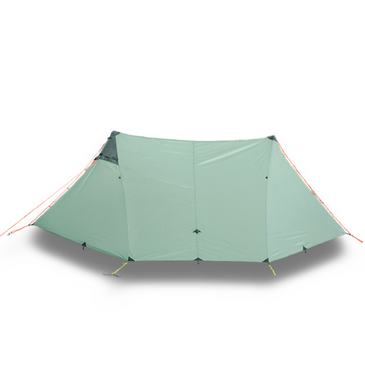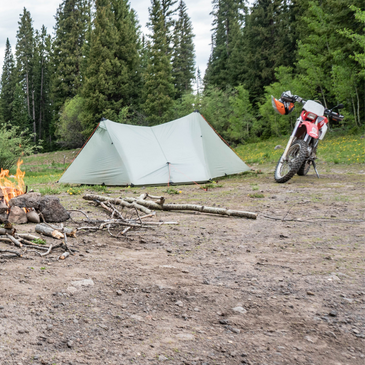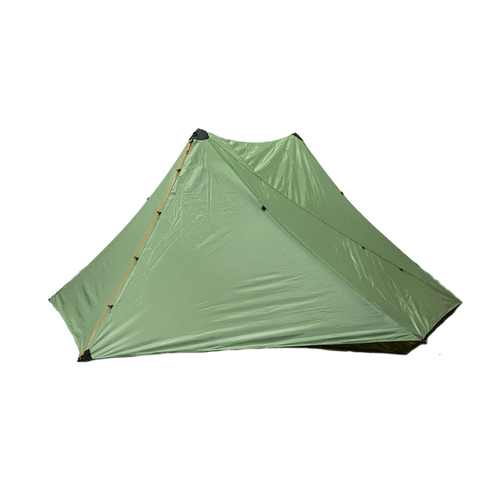
Guardian 2p xl
OVERVIEW:
Guardian - A 13,617 foot peak in the San Juan Range of mountains in Southwest Colorado.
The Guardian 2p XL is an ultralight two person trekking-pole-pitched tent that is lightweight enough for solo trips, but big enough to sleep two people over 6' tall. It's bigger and slightly heavier than the Silex, but that means more sleeping area and room for gear when using a wood-burning tent stove.
The Guardian pitches with two trekking poles and the small footprint means you can squeeze it into tight spots. Careful catenary cuts allow for good seam tension which translates to better wind and weather performance.
Our patented Zipperless Doors make this tent easy to use. Zipperless doors offer better durability and lighter weight compared to traditional zippered entry tents.
Handmade in Grand Junction, CO.
FEATURES:
- Pitches with two trekking poles (or two of our carbon fiber poles)
- Zipperless Doors
- Sized for two 6'5" men, but light enough for solo use
- When used as a hot tent, you can't use the nest and a stove at the same time.
- Fabric is a 30D Cordura spec silnylon. Read more - Tent Fabrics - A Comparison Of Fabric Types
OPTIONS:
- Shelter Stove Jack
- Select with or without stove jack. Stove jack adds 4 ounces, and makes it possible to use a wood burning tent stove for four season camps
- Floor System
- The floor and partial liner system is specially made for the Guardian. It covers the floor area from pole to pole, gives 2 feet of interior liner coverage, and provides a small bathtub floor. 12 oz
- Nest
- Best for complete bug and moisture protection. At 29 oz with bathtub floor, Noseeum mesh, and DWR fabric, the nest fits 2 comfortably and fully encloses the shelter from the elements
- Poles
- For users who do not take trekking poles, or for users who don't want to sacrifice both poles to the shelter. Pole weighs 4.2 oz each and break down into 4 sections, each section is 16.1" long. If you want one or two poles click the link - Carbon Pole for Trekking Pole Tents
- Seam Sealing
- Have us seem seal it for you or choose to do it yourself
SPECIFICATIONS:
- Weights:
- Canopy without stovejack, stakes, stuff sacks, & cordage - 29 oz
- Canopy with stovejack, stakes, stuff sacks, & cordage - 33 oz
- Dimensions:
- Height: 51"
- Door to door: 142"
- Width: 110"
- Pole to pole width: 70"
- Sqft total area: 70 | Sqft sleeping area: 45
- Large percentage of usable space.
- Fabric
- 30D Cordura spec ripstop double coated silnylon.
- Hydrostatic head rating 3000-4000 mm.
PITCHING:
- Stake out the center rectangular portion.
- Insert a pole into the pole pocket and raise, then stake out the door guyline.
- Common problems are having the door stakes too far from the pole, creating sag in the ridgeline. Move the door stake closer to the pole by taking up slack in the line at the top, and this will solve the sag issues.
PITCHING THE NEST:
PITCHING THE FLOOR SYSTEM:
SEAM SEALING:
For best results we recommend seam sealing your tent. You can do it at home or have us do it for you (if we seal the shelter it will be shipped without extra tubes of sealant):
- We send our shelters with enough seam sealer to seal the entire shelter.
- Pitch the shelter normally and seal the outside seams.
- The easy way to seal is to run a thin bead of sealant along the seam, then press it in with a finger, wiping the excess on a paper towel.
- Alternatively, you can use an acid brush from a hardware store to spread the sealant.
COMES WITH:
- Shelter canopy
- 8 Stakes
- Stuff Sack
- Seam Sealer (If you don't have us seam seal it.)
- Does not come with poles. This shelter is intended to pitch with two 120 to 140 cm trekking poles.
FAQ:
Q. What are the differences in the Silex and Guardian?A. The Silex is a solo hot tent, the Guardian is a two person ultralight hot tent.
Q. What are the differences in the Eolus and Guardian?
A. The Eolus is a smaller and lighter weight shelter for two people, but you can't use a stove in the Eolus with two people. The Guardian door opens taller than the Eolus, making it easier to enter and exit.
Q: What are the differences in the Guardian and the Cimarron?
A: The Cimarron is more spacious for two people with a stove, but quite a bit heavier for solo use. The Guardian fits solidly into the big solo or ultralight two person hot tent category.










